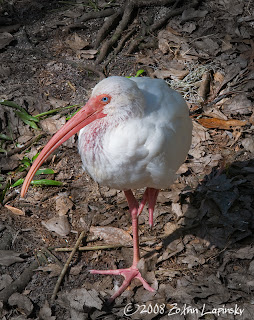 Homosassas Springs Wildlife State Park sits just east of the Gulf of Mexico, and the warm, shallow, clear river way into the park attracts all sorts of sea creatures and birds. The undisputed stars, however, are the manatees. The park is home to several injured manatees who would not survive in the wild, many of their injuries caused by powerboats. They are kept inside the park by gates submerged in the water that have openings large enough to allow water and fish to pass through, but too small for the manatee. On the gulf side of the gate, wild manatees swim into the cove where they come nostril to camera lens with hoards of manatee watchers in boats, canoes, kayaks, and snorkel gear, eager to catch a glimpse of the huge "sea cows."
Homosassas Springs Wildlife State Park sits just east of the Gulf of Mexico, and the warm, shallow, clear river way into the park attracts all sorts of sea creatures and birds. The undisputed stars, however, are the manatees. The park is home to several injured manatees who would not survive in the wild, many of their injuries caused by powerboats. They are kept inside the park by gates submerged in the water that have openings large enough to allow water and fish to pass through, but too small for the manatee. On the gulf side of the gate, wild manatees swim into the cove where they come nostril to camera lens with hoards of manatee watchers in boats, canoes, kayaks, and snorkel gear, eager to catch a glimpse of the huge "sea cows." This is manatee mating time, and there is, at least by manatee standards, one really hot manatee lady in these waters. She swam in, and her suitors followed. This type of manatee group is called a mating herd. Most of the males "get lucky" in a mating herd, and 12 months later a really cute little manatee baby will be the result -- but the paternity will only be known if the humans do a DNA test.
This is manatee mating time, and there is, at least by manatee standards, one really hot manatee lady in these waters. She swam in, and her suitors followed. This type of manatee group is called a mating herd. Most of the males "get lucky" in a mating herd, and 12 months later a really cute little manatee baby will be the result -- but the paternity will only be known if the humans do a DNA test.
 Manatees are mammals, so they need to come up for air periodically. Often all you see is their nose sticking up from the water, but manatees in a mating herd are much more active and frequently break the surface of the water as they cavort in the mating ritual. They are herbivores, and are the only mammal known to grow replacement teeth throughout their life. The park has a full manatee skeleton on display, showing the bones of five fingers and finger nails, in life hidden inside their flipper. These finger joints allow them to feed more easily, and female manatees have been seen "holding" their babies with the flippers.
Manatees are mammals, so they need to come up for air periodically. Often all you see is their nose sticking up from the water, but manatees in a mating herd are much more active and frequently break the surface of the water as they cavort in the mating ritual. They are herbivores, and are the only mammal known to grow replacement teeth throughout their life. The park has a full manatee skeleton on display, showing the bones of five fingers and finger nails, in life hidden inside their flipper. These finger joints allow them to feed more easily, and female manatees have been seen "holding" their babies with the flippers.
While the manatees are a crowd favorite, the park is also home to all sorts of birds, fish, and reptiles. Some of the birds are captive, but others are free flying. Here are some more pictures from the day (click on image to enlarge):






No comments:
Post a Comment